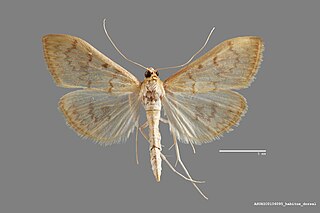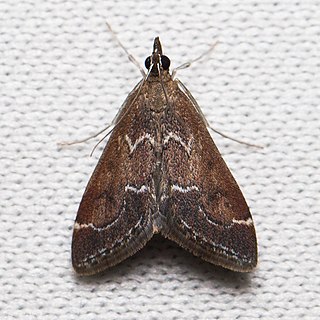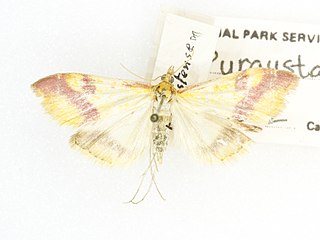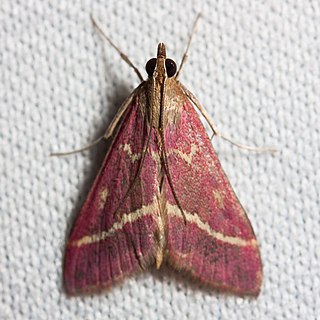
Pyrausta is a speciose genus of moths of the family Crambidae. The genus was erected by Franz von Paula Schrank in 1802.
Abegesta remellalis, the white-trimmed abegesta or white-trimmed brown pyralid moth , is a moth in the family Crambidae. It was described by Herbert Druce in 1899. It is found in Mexico and the south-western United States, where it has been recorded from Arizona, California and New Mexico.

Hahncappsia mellinialis is a moth in the family Crambidae. It was described by Herbert Druce in 1899. It is found in Colorado, Arizona, New Mexico, Mexico and Guatemala.
Helvibotys pucilla is a moth in the family Crambidae first described by Herbert Druce in 1895. It is found in Guatemala, Costa Rica, the Mexican state of Veracruz and the United States, where it has been recorded from Kentucky, Oklahoma and Texas

Pyrausta corinthalis is a moth in the family Crambidae. It was described by William Barnes and James Halliday McDunnough in 1914. It is found in Mexico and the United States, where it has been recorded from California and Arizona.
Pyrausta deidamialis is a moth in the family Crambidae. It was described by Herbert Druce in 1895. It is found in Mexico (Xalapa), Costa Rica and Panama.

Pyrausta flavofascialis is a moth in the family Crambidae. It was described by Augustus Radcliffe Grote in 1882. It is found in North America, where it has been recorded from western Texas to Arizona. It is also found in Mexico.

Pyrausta inornatalis, the inornate pyrausta moth, is a moth in the family Crambidae. It was described by Charles H. Fernald in 1885. It is found in United States, where it has been recorded from Arizona, California, Florida, Arkansas, Kansas, Louisiana, Missouri, Oklahoma, Tennessee and Texas. It is also found in Mexico.

Pyrausta napaealis is a moth in the family Crambidae. It was described by George Duryea Hulst in 1886. It is found in the United States, where it has been recorded from Washington to California and west to Arizona, Nevada, New Mexico and Texas. It is also found in northern Mexico.

Pyrausta nexalis, the fulvous-edged pyrausta moth, is a moth in the family Crambidae. It was described by George Duryea Hulst in 1886. It is found in North America, where it has been recorded from Washington, Montana, Arizona, California, New Mexico, Oklahoma, Texas and Utah.

Pyrausta perrubralis is a moth in the family Crambidae. It was described by Packard in 1873. It is found in North America, where it has been recorded from British Columbia, California, New Mexico, Oregon and Washington.
Pyrausta prochytalis is a moth in the family Crambidae. It was described by Herbert Druce in 1895. It is found in Guatemala.

Pyrausta pseuderosnealis is a moth in the family Crambidae. It was described by Eugene G. Munroe in 1976. It is found in Mexico and the United States, where it has been recorded from California, Texas, Florida, Alabama, Georgia, Iowa, Mississippi, South Carolina, Louisiana, Arkansas, Missouri, Illinois and Oklahoma.

Pyrausta pseudonythesalis, the Shasta pyrausta moth, is a moth in the family Crambidae. It was described by Eugene G. Munroe in 1976. It is found in North America, where it has been recorded from California, Nevada, Arizona, New Mexico and Texas.
Pyrausta salvia is a moth in the family Crambidae. It was described by Herbert Druce in 1895. It is found in Guerrero, Mexico.

Pyrausta scurralis is a moth in the family Crambidae. It was first observed and described by George Duryea Hulst in 1886. It is found in North America, where it has been recorded/reported in the Canadian provinces of Ontario, Manitoba and Saskatchewan to the US states, California, Arizona, and New Mexico and in Mexico.

Pyrausta subsequalis, also known as the weedfield sable, is a moth in the family Crambidae. It was described by Achille Guenée in 1854. It is found in North America, where it has been recorded from southern Alberta and southern British Columbia south to Arizona and New Mexico. The habitat consists of dry prairie areas.

Pyrausta tyralis, the coffee-loving pyrausta moth, is a moth in the family Crambidae. It was described by Achille Guenée in 1854. It is found in the United States, where it has been recorded from New York to Illinois and from Florida to Arizona. It is also found from Mexico to Venezuela, as well as on the West Indies.

Pyrausta volupialis, the volupial pyrausta moth, is a moth in the family Crambidae. It was described by Augustus Radcliffe Grote in 1877. It is found in North America, where it has been recorded from Oklahoma, Utah, Texas, Colorado, New Mexico, Arizona and California to Chiapas, Mexico.
Conchylodes salamisalis, the blush conchylodes moth, is a moth in the family Crambidae. It was described by Herbert Druce in 1895. It is found in Ecuador, Costa Rica, Panama, Guatemala, Mexico and the southern United States, where it has been recorded from Texas.














